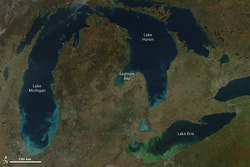Green Waters: Algae in the Great Lakes
Links to more info:
· Microcystis fact sheet
· Blue Green vs. Green Algae fact sheet · Ohio Sea Grant fact sheet · https://www.youtube.com/watch?v=3z29XaBkKPk (More about Cladophora in Wisconsin) · http://www.rtknet.org/ (Learn more about chemical Spills and Accidents in your community) · The Beach Manager’s Manual: Harmful Algal Blooms · Reducing Nitrogen Export from the Corn Belt to the Gulf of Mexico: Agricultural Strategies for Remediating Hypoxia (Technical Paper on Reducing Nitrates) |
 Green is algae (blue is sediment).
Photo by NASA's Earth Observatory (Sediment and Algae Color the Great Lakes) [CC BY 2.0 (http://creativecommons.org/licenses/by/2.0)], via Wikimedia Commons. Green is algae (blue is sediment).
Photo by NASA's Earth Observatory (Sediment and Algae Color the Great Lakes) [CC BY 2.0 (http://creativecommons.org/licenses/by/2.0)], via Wikimedia Commons.
In August 2014 there was a major catastrophe impacting drinking water in the United States.
A toxic blue-green algae bloom of Microcystis - which can produce Microcystin, a liver toxin and skin irritant - settled over the water intake in Lake Erie for Toledo, Ohio. For three days a community of 500,000 people were not able use their tap water. These types of algae blooms have not only impacted Lake Erie but also Michigan's Grand Traverse Bay and Wisconsin's Green Bay in Lake Michigan. Further, an overgrowth of the Cladophora Algae has been impacting Indiana and Wisconsin's Beaches. The algae blooms have been attributed to excessive nutrient overloads of phosphates and nitrates to the waterways primarily from agricultural run-off. While the problem is well known the solutions have been slow in being implemented. Ohio has this legislative session introduced a bill to reduce the discharges of phosphorus to their waterways. LWV Lake Michigan Region has a PowerPoint presentation available to any organization which explains in detail the problem, where it is occurring and what individuals and Leagues can do to help reduce the nutrient overloads to Lake Michigan and its tributaries. Jeanette Neagu can be contacted for more information and to schedule a presentation at 219 879 0431 or [email protected]. |
